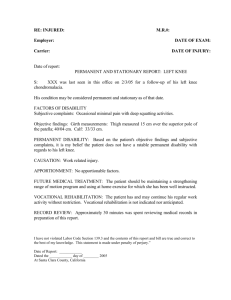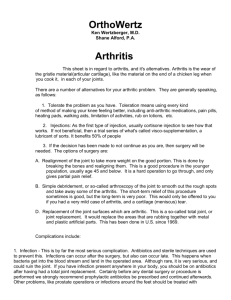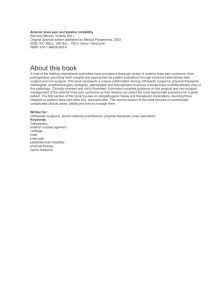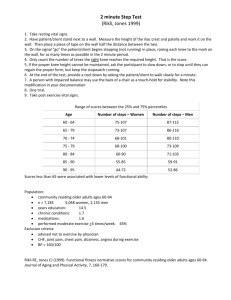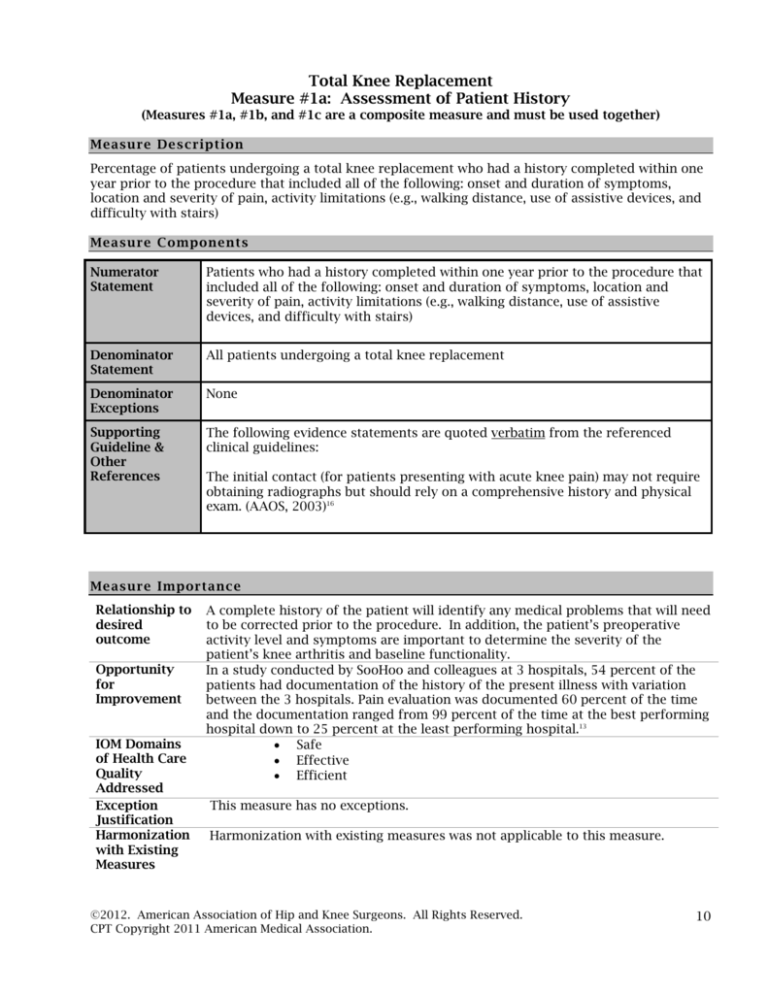
Total Knee Replacement
Measure #1a: Assessment of Patient History
(Measures #1a, #1b, and #1c are a composite measure and must be used together)
M eas ur e Des c r ipt io n
Percentage of patients undergoing a total knee replacement who had a history completed within one
year prior to the procedure that included all of the following: onset and duration of symptoms,
location and severity of pain, activity limitations (e.g., walking distance, use of assistive devices, and
difficulty with stairs)
Meas ure C o mponents
Numerator
Statement
Patients who had a history completed within one year prior to the procedure that
included all of the following: onset and duration of symptoms, location and
severity of pain, activity limitations (e.g., walking distance, use of assistive
devices, and difficulty with stairs)
Denominator
Statement
All patients undergoing a total knee replacement
Denominator
Exceptions
None
Supporting
Guideline &
Other
References
The following evidence statements are quoted verbatim from the referenced
clinical guidelines:
The initial contact (for patients presenting with acute knee pain) may not require
obtaining radiographs but should rely on a comprehensive history and physical
exam. (AAOS, 2003)16
M e as ur e Imp or ta n ce
Relationship to
desired
outcome
Opportunity
for
Improvement
IOM Domains
of Health Care
Quality
Addressed
Exception
Justification
Harmonization
with Existing
Measures
A complete history of the patient will identify any medical problems that will need
to be corrected prior to the procedure. In addition, the patient’s preoperative
activity level and symptoms are important to determine the severity of the
patient’s knee arthritis and baseline functionality.
In a study conducted by SooHoo and colleagues at 3 hospitals, 54 percent of the
patients had documentation of the history of the present illness with variation
between the 3 hospitals. Pain evaluation was documented 60 percent of the time
and the documentation ranged from 99 percent of the time at the best performing
hospital down to 25 percent at the least performing hospital.13
Safe
Effective
Efficient
This measure has no exceptions.
Harmonization with existing measures was not applicable to this measure.
©2012. American Association of Hip and Knee Surgeons. All Rights Reserved.
CPT Copyright 2011 American Medical Association.
10
M eas ur e Des i gna t io n
Measure purpose
Type of measure
Level of
Measurement
Care setting
Data source
Quality improvement
Accountability
Process
Individual practitioner
Ambulatory care
Electronic health record (EHR) data
Administrative Data/Claims (inpatient or outpatient claims)
Administrative Data/Claims Expanded (multiple-source)
Paper medical record
Registry data
Technica l Specifications: Administrative/C laims Data
Administrative claims data collection requires users to identify the eligible population
(denominator) and numerator using codes recorded on claims or billing forms (electronic or
paper). Users report a rate based on all patients in a given practice for whom data are
available and who meet the eligible population/denominator criteria.
The specifications listed below are those needed for performance calculation. Additional CPT II
codes may be required depending on how measures are implemented. (Reporting vs.
Performance)
Denominator
(Eligible
Population)
All patients undergoing a total knee replacement
CPT Service Code: 27446, 27447, 27438, or 27442
Numerator
Patients who had a history completed within one year prior to the
procedure that included all of the following: onset and duration of
symptoms, location and severity of pain, activity limitations (e.g., walking
distance, use of assistive devices, and difficulty with stairs),
Report the CPT Category II code:
XXXXF: Patients who had a history completed in development for this
numerator
©2012. American Association of Hip and Knee Surgeons. All Rights Reserved.
CPT Copyright 2011 American Medical Association.
11
Total Knee Replacement
Measure #1b: Physical Examination
(Measures #1a, #1b, and #1c are a composite measure and must be used together)
M eas ur e Des c r ipt io n
Percentage of patients undergoing a total knee replacement who had a physical examination
completed within one year prior to the procedure that included all of the following: gait, knee range
of motion, presence or absence of deformity of the knee, stability of the knee, neurologic status
(sensory and motor function), vascular status (peripheral pulses), skin, height, and weight
Meas ure C o mponents
Numerator
Statement
Patients who had a physical examination completed within one year prior to the
procedure that included all of the following: gait, knee range of motion, presence
or absence of deformity of the knee, stability of the knee, neurologic status
(sensory and motor function), vascular status (peripheral pulses), skin, height,
and weight
Denominator
Statement
All patients undergoing a total knee replacement
Denominator
Exceptions
None
Supporting
Guideline &
Other
References
The following evidence statements are quoted verbatim from the referenced
clinical guidelines:
The initial contact (for patients presenting with acute knee pain) may not require
obtaining radiographs but should rely on a comprehensive history and physical
exam.
Significant Physical Examination:
Visual inspection for abnormalities
Presence and location of warmth
Tenderness (location)
Presence and location of swelling
Range of motion (active and passive)
Meniscal compression
Varus/valgus instability (0º and 30º of flexion)
Anterior Drawer with + or – Lachman
Foot pulse
Presence and location of erythema
Hip pain or abnormalities present
Patella apprehension
Crepitance (AAOS, 2003) 15
On physical examination, patients with OA often have tenderness on palpation,
bony enlargement, crepitus on motion, and/or limitation of joint motion.
(American College of Rheumatology, 2000)17
M e as ur e Imp or ta n ce
Relationship to
desired
A complete examination of the knee is necessary to plan for the surgical
procedure. In addition, the patient’s preoperative evaluation is important to
©2012. American Association of Hip and Knee Surgeons. All Rights Reserved.
CPT Copyright 2011 American Medical Association.
12
outcome
Opportunity
for
Improvement
IOM Domains
of Health Care
Quality
Addressed
Exception
Justification
Harmonization
with Existing
Measures
determine the severity of the patient’s knee arthritis and baseline functionality.
A study conducted by SooHoo and colleagues found that all components of the
physical examination were documented only 5 percent of the time for the patients
undergoing total knee replacement at the 3 hospitals.13
Safe
Effective
Efficient
This measure has no exceptions.
The American Medical Association (AMA)-convened Physician Consortium for
Performance Improvement® (PCPI™) osteoarthritis measure addressing the
physical examination of the involved joint includes visual inspection, palpation,
and degree of range of motion of the joint. This measure addresses additional
items that should be documented in the medical record prior to total knee
replacement.
M eas ur e Des i gna t io n
Measure purpose
Type of measure
Level of
Measurement
Care setting
Data source
Quality improvement
Accountability
Process
Individual practitioner
Ambulatory care
Electronic health record (EHR) data
Administrative Data/Claims (inpatient or outpatient claims)
Administrative Data/Claims Expanded (multiple-source)
Paper medical record
Registry data
Technica l Specifications: Administrative/C laims Data
Administrative claims data collection requires users to identify the eligible population
(denominator) and numerator using codes recorded on claims or billing forms (electronic or
paper). Users report a rate based on all patients in a given practice for whom data are
available and who meet the eligible population/denominator criteria.
The specifications listed below are those needed for performance calculation. Additional CPT II
codes may be required depending on how measures are implemented. (Reporting vs.
Performance)
Denominator
(Eligible
Population)
All patients undergoing a total knee replacement
Numerator
Patients who had a physical examination completed within one year prior to
the procedure that included all of the following: gait, knee range of motion,
presence or absence of deformity of the knee, stability of the knee,
neurologic status (sensory and motor function), vascular status (peripheral
pulses), skin, height, and weight
CPT Service Code: 27446, 27447, 27438, or 27442
Report the CPT Category II code:
XXXXF: Patients who had a physical examination completed in development
for this numerator
©2012. American Association of Hip and Knee Surgeons. All Rights Reserved.
CPT Copyright 2011 American Medical Association.
13
Total Knee Replacement
Measure #1c: Radiographic Evidence of Arthritis
(Measures #1a, #1b, and #1c are a composite measure and must be used together)
M eas ur e Des c r ipt io n
Percentage of patients undergoing a total knee replacement with radiographic evidence of arthritis
within one year prior to the procedure
Meas ure C o mponents
Numerator
Statement
Patients with radiographic evidence of arthritis within one year prior to the
procedure
Denominator
Statement
All patients undergoing a total knee replacement
Denominator
Exceptions
Documentation of medical reason for no radiographic evidence of arthritis (e.g.,
patients with osteonecrosis or bone tumor, MRI studies showing full thickness
cartilage loss)
Supporting
Guideline &
Other
References
The following evidence statements are quoted verbatim from the referenced
clinical guidelines:
Candidates for elective TKR should have radiographic evidence of joint damage,
moderate to severe persistent pain that is not adequately relieved by an extended
course of nonsurgical management, and clinically significant functional limitation
resulting in diminished quality of life. (NIH Consensus Statement 2003)18
M e as ur e Imp or ta n ce
Relationship to
desired
outcome
Opportunity
for
Improvement
IOM Domains
of Health Care
Quality
Addressed
Exception
Justification
Harmonization
with Existing
Measures
Prior to total knee replacement, there should be radiographic evidence of arthritis
including joint space narrowing and deformity.
Radiographic evidence of arthritis was identified 80 percent of the time on the
patients undergoing total knee replacement at the 3 California hospitals studied
by SooHoo and colleagues. Adherence ranged from 71 to 85 percent.13
Safe
Effective
Efficient
A denominator exception has been added to capture those patients who require
total knee replacement due to osteonecrosis or a bone tumor.
Harmonization with existing measures was not applicable to this measure.
M eas ur e Des i gna t io n
Measure purpose
Quality improvement
Accountability
©2012. American Association of Hip and Knee Surgeons. All Rights Reserved.
CPT Copyright 2011 American Medical Association.
14
Type of measure
Level of
Measurement
Care setting
Data source
Process
Individual practitioner
Ambulatory care
Electronic health record (EHR) data
Administrative Data/Claims (inpatient or outpatient claims)
Administrative Data/Claims Expanded (multiple-source)
Paper medical record
Registry data
Technica l Specifications: Administrative/C laims Data
Administrative claims data collection requires users to identify the eligible population
(denominator) and numerator using codes recorded on claims or billing forms (electronic or
paper). Users report a rate based on all patients in a given practice for whom data are
available and who meet the eligible population/denominator criteria.
The specifications listed below are those needed for performance calculation. Additional CPT II
codes may be required depending on how measures are implemented. (Reporting vs.
Performance)
Denominator
(Eligible
Population)
All patients undergoing a total knee replacement
Numerator
Patients with documented radiographic evidence of arthritis within one year
prior to the total knee replacement
CPT Service Code: 27446, 27447, 27438, or 27442
Report the CPT Category II code:
XXXXF: Patients with radiographic evidence of arthritis in development for
this numerator
Denominator
Exceptions
Documentation of medical reason for no radiographic evidence of arthritis
(e.g., patients with osteonecrosis or bone tumor, MRI studies showing full
thickness cartilage loss))
Append modifier to CPT Category II code: XXXXF-1P
©2012. American Association of Hip and Knee Surgeons. All Rights Reserved.
CPT Copyright 2011 American Medical Association.
15



